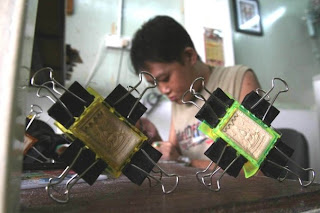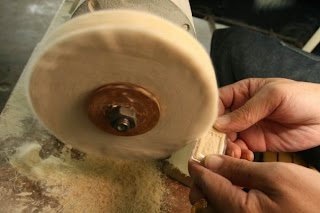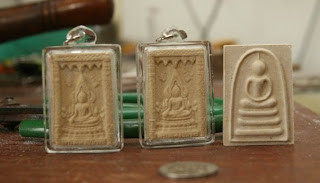The Making Of Amulet Plastic Casing
1.包裝佛牌最重要的用具、就是朔膠板、是要依照佛牌的大小心型狀來鋸開。
2.當朔膠板鋸開后、用慢火將朔膠板烘軟、方便製成大小形狀。
3.當朔膠板製成佛牌大小形狀后、在用膠水將兩邊黏住。
4.當用膠水將佛牌黏住后、再將用夾子將佛牌夾住、以確保佛牌更有耐久
5.將即將完工的佛牌打臘、讓整個佛牌感覺很滑面。
6.完成、左邊2個是已經完工的不同包裝型、而在右邊的是尚未動工的佛牌只是一塊普通的佛牌而已。
DIY - My Amulet Chain
In Singapore, its very hard to get the suitable accessories and materials to DIY the amulet chain. Even can buy the custom made chains in certain amulet shops, but the price are so expensive....
This is one of my DIY amulet chain, I was bought the materials in singapore from different amulet retail shops. In order to collect my suitable materials to make my chain, I had spent for 3-4months, and the costs is around $50.
Exploring Amulet Market in Thailand
Thai Amulet Market - beside the temple Wat Mahathat, between Maharat Road and the river, is the larggest amulet market in Bangkok, where a fantastic array of religious amulets, charms, talismans, and traditional medicine is sold. On there, we are sure able to find the materials to DIY amulet chains and the price are much more cheaper. One of the Best Temples in the world - Wat Rong Khun (White Temple), The Art of Lord Buddha
The famous Wat Rong Khun or White Temple, located near the city of Chiang Rai, Thailand, about 5 kilometers to the south. It is established by a well-known Thai artist Chalermchai Kositpipat, who wanted to build a temple all in white to signify the purity of Lord Buddha. The construction had began in year 1997.
The temple is designed in white color with some use of white glass.
The white color stands for Lord Buddha’s purity;
The white glass stands for Lord Buddha’s wisdom that "shines brightly all over the Earth and the Universe."
Wat Rong Khun consists of 9 buildings: the ubosot, the hall containing Lord Buddha’s relics, the hall containing Buddha images, the preaching hall, the contemplation hall, the monk’s cell, the door façade of the Buddhavasa, the art gallery, and the toilets.
The bridge leading to the temple represents the crossing over from the cycle of rebirth to the Abode of Buddha.
The small semicircle before the bridge stands for the human world. The big circle with fangs is the mouth of Rahu, meaning impurities in the mind, a representation of hell or suffering.
All the paintings inside the assembly hall have golden tones. The four walls, ceiling and floor contain paintings showing an escape from the defilements of temptation to reach a supramundane state. On the roof, there are four kinds of animals representing earth, water, wind and fire. The elephant stands for the earth; the naga stands for water; the swan's wings represent wind; and the lion’s mane represents fire.
For more information about the design and meaning of the temple, please visit
http://web.chiangrai.net/tourcr/e_version/index.php?option=rongkhun
Uttamayanmuni Buddhist Temple 1962 ( Tok Raja Temple in Singapore )
Uttamayanmuni Buddhist Temple 1962 ( Tok Raja Temple in Singapore ), located at 32-b Hong San Terrace, near Choa Chu Kang MRT.
http://web.chiangrai.net/tourcr/e_version/index.php?option=rongkhun
Uttamayanmuni Buddhist Temple 1962 ( Tok Raja Temple in Singapore )
 |
Uttamayanmuni Buddhist Temple - Tok Raja Temple that located in Singapore
 |
| This is very rare that we can found Phra Pidta big bucha in Singapore temple, but this altar is located at Uttamayanmuni Buddhist Temple, right-hand-side after enter the main gate. |
So Cool...Hehe
Uttamayanmuni Buddhist Temple 1962 ( Tok Raja Temple in Singapore ), located at 32-b Hong San Terrace, near Choa Chu Kang MRT.
It began with Jao Khun Wijaranyanmuni (Jao Khun Khron, 1876-1962), the late chief abbot of Wat Uttamaram (also known as Wat Bang Saet) in the village of Bang Saet, Pasir Mas, Kelantan. He was the former chief monk of Kelantan and the first known monk in Kelantan to have received the monastic title of Jao Khun (although he passed away 15 days before he was to receive the ceremonial fan of office from King Phumiphol). In 1962 (BE 2505), Jao Khun Khron was invited to visit Singapore by his devotees here. It was on this trip that he informed his followers of his intention to have a piece of land in Singapore to build a temple. Mr Tan Khe Wat, a Singaporean Chinese man was present when the monk spoke of his intent and willingly offered him a piece of land 2.5 ha in size to Jao Khun Khron.
A short time after having been given the land, Jao Khun Khron passed away...
For more details about Uttamayanmuni Temple, please visit http://www.uttamayanmuni.org/index.html
Thai Sak Yant Tattoos
The tradition in ancient Thailand that warriors be tattooed in order to make their bodies slippery and hard to grab in battle has caused many Yant tattoo designs to be developed that are intended to protect against penetrative weapons, such as guns or knives. Thais believed that if you are covered with yant tattoos, it will make your skin slippery and hard to penetrate with a sharp weapon.
These tattoos originate from the pre Buddhist era and the markings were a mixture of Buddhist prayers and sorcery spells and referred to as Sak Yant. They were applied not with a needle but with a sharpened stick, rather like the old fashioned quill used for writing, tapped into the skin.
Today, tattoos are very popular in Thailand and the rest of the World as a fashion statement and there are thousands of designs available.

















